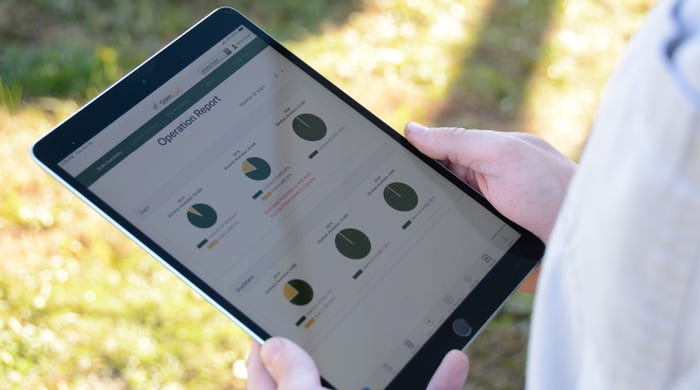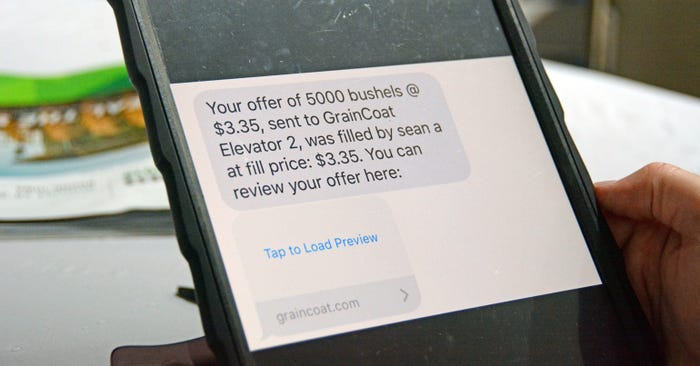
What’s the most farmer-like thing to do when you can’t find what you need?
Answer: Build it yourself.
That’s exactly what Sean Arians did when he couldn’t find a hand-held way to track his grain inventory and execute sales — only this time, he didn’t need duct tape or baling wire.
Instead, he hatched a plan in the tractor last fall and phoned a friend. That friend just happened to be an app developer.
Arians explained what he needed: an easier way to keep track of his grain marketing. He wanted to know how much he’d sold and how much he had left. It had to be cheap, easy and effective, and it couldn’t involve an Excel spreadsheet.
What he didn’t need: accounting software (had it already), or anything that required a lot of data entry on his part. Or that was expensive.
“When I get the markets on my phone and I realize that the market is up, I want to be able to take advantage of that,” Arians explains. “I need to know ‘How sold am I?’ and ‘Where do I want to be?’”
Arians farms near Morrison, Ill., and has worked in marketing and education for Precision Planting, The Climate Corporation and, now, Bayer Crop Science. Those positions put him in the orbit of app developers and helped him realize he needed a better way to manage his farm business from afar. Then, as he listened to a book in the tractor last fall that urged him to be “obsessed instead of average,” he realized he had a marketable idea.
Enter GrainCoat. It’s both software and an app that lets you track grain inventory on the fly and sell grain when the market changes. The free version lets you log in and create an account, and projects bushels of production. The subscription-based version, known as GrainCoat Advantage, costs $199 a year and features:
• contract and delivery summaries
• contract communication with elevator (via text or email)
• annual or monthly inventory report
• tracking by farm or field
• forecast projections
• updated markets
• access for multiple operations
Arians’ advantage
As a farmer with an off-farm job, and not a lot of excess time on his hands, Arians knew he needed a better way to manage data and track crop sales one and two years in advance.
“What I’ve realized is that when I can sell a year ahead or two years ahead, that’s the best marketing opportunity,” he says. But that means updating spreadsheets that far in advance.
“I don’t track it that far ahead, and neither do most of the farmers I’ve dealt with,” he says. So, he built that feature into the app.
When you create your account, you see your projection for this year based on your estimated yield; then you see actual production history for future years. “That way you realize that you’re always long grain, and that you need to be able to take advantage of the market when the market moves,” Arians says.
 PHILOSOPHY: Sean Arians says his aim with GrainCoat is to help maximize farmers’ long-range averages over the years by making mobile grain marketing easier to track and execute. “It’s about farmers and how do I think long-term in my operation?” he says.
PHILOSOPHY: Sean Arians says his aim with GrainCoat is to help maximize farmers’ long-range averages over the years by making mobile grain marketing easier to track and execute. “It’s about farmers and how do I think long-term in my operation?” he says.

Arians also built in a tax valuation help, knowing it’s not very efficient to gather up scraps of paper and enter them in a spreadsheet. Farmers can generate an end-of-year report, which could essentially be a month-to-month report, as well. The inventory value is determined by delayed futures data.
“It’s meant to be a really quick way to get that number for your tax person or for your banker, without having to go through and find inventory to find values,” Arians says.
What it doesn’t do
The app is solely focused on grain inventory and sales. It doesn’t track cost of production or cost of inputs such as chemicals, fertilizers, seed, etc.
“My goal is to do that really well because there’s a lot of people out there talking about everything else today,” he says.
Arians wants his customers to be able to focus on grain sales, and not get distracted by bar charts that show “the market was up today so I made 20 grand, or the market was down today and I lost 20 grand.”
“That’s not the right marketing plan,” he says.
Instead, he says the app allows a farmer to plan ahead and sell in advance, and to know exactly how much grain is sold, no matter where the farmer is standing (or sitting) at that moment.
Farmers can also enter their inventory locations, and the app will compare estimated production to on-farm grain storage. The idea is to help them visualize storage capacity and make sales so they don’t have to store at the elevator.
“This is all about triggering the action of selling something to get ahead of the market and maximize the return for the farmer,” Arians says. “That’s why we show that.”
No calls necessary
Part of the beauty of the GrainCoat system, according to Arians, is that you don’t have to pick up the phone to make a grain sale.
“I can’t always make a phone call, if I’m in a meeting or I’m somewhere I can’t talk. But I may still want to take advantage of the market where it is.”
If the market moves and you want to make a sale, you can put an offer in through GrainCoat. You will have already entered your elevators and established a relationship with them via GrainCoat. When you put in the offer, the app generates an email or text to the elevator, and they acknowledge it.
The elevator can accept it, and then it shows up in the GrainCoat system. Once the order is filled, either the elevator or the farmer can enter the contract number. Once the sale is marked filled, it shows up as sold bushels in the app.
 COMMUNICATION: GrainCoat generates texts or emails between the farmer and the elevator as soon as a contract is executed, and automatically updates the farmer’s GrainCoat account.
COMMUNICATION: GrainCoat generates texts or emails between the farmer and the elevator as soon as a contract is executed, and automatically updates the farmer’s GrainCoat account.

GrainCoat isn’t offering marketing advice or acting as an agent.
“It’s still a contract between you and the elevator — not anything to do with us,” Arians says. “We’re just the intermediary that’s allowing you to communicate.”
Data dump?
Arians says all data is secure and belongs to the farmer. He can’t even see the information farmers enter, because it’s in the farmer’s account. Technically, the developer will be able to access that information but only for support purposes, as outlined in a privacy statement.
Once a farmer has created an account and logged planting intentions, the system triggers two notifications a year. The first comes midseason and asks you to verify whether you planted what you intended to plant, or if you switched any acres. The second comes after harvest, asking you to verify your yields.
The app is available at graincoat.com. The iPad version will be available by mid- to late December; Arians hopes to have the iPhone version after the first of the year and will pursue an Android version after that.
The subscription version of GrainCoat is free for student use for six months. Arians says he wants to make the program available as a tool to teachers and professors who are teaching grain marketing.
“Part of my goal is trying to give back, having been an FFA member and been very involved,” he says.
About the Author(s)
You May Also Like






